The revitalization of traditional music proceeds in various directions, and this article concentrates on gatherings of traditional singers and musicians (hereinafter called “gatherings”); the main purpose of such gatherings is to represent traditional music as a conscious and systematic concept. Representational and conservational directives have been part of gatherings since the beginning (the first gathering was organized in Ribnica, Lower Carniola in 1973) and simultaneously such gatherings have became part of the stream of other revitalizations of traditional music; at the same time, with their conscious directing of content and aesthetic characteristics of traditional music, they represent its institutionalization beginning.
The history of gatherings goes back to the early 70s of the 20th century. In the initial period, gathering presented traditional dance and music culture-referred to as gatherings of traditional singers, musicians and dancers (Sln. srečanja ljudskih pevcev, godcev in plesalcev),[1] later these events were formed separately for singers and musicians, and for dancers. Researchers of the Institute of Ethnomusicology (Sln. ZRC SAZU, Glasbenonarodopisni inštitut, Ljubljana, Slovenia)[2] created the first guidelines for event structure (Ramovš 2006). These researchers had the necessary professional expertise and extensive fieldwork practice required for forming the program of the event. Even today, ideas of conservation of the so-called original traditional singing and instrumental music are emphasized at these gatherings; presenting the so called original culture of singing,[3] instrument playing and dancing remains at the centre even nowadays, even though another state institution, the Culture and Educational Organizations Federation (Sln. Zveza kulturnih prosvetnih organizacij), has been organizing these events since the beginning of 1973.[4]
Gatherings have been organized continuously, however currently the form and structure of such events is scarcely associated with its beginnings. One of the successors to the original Association of Cultural Organizations, i.e. the Public Fund for Cultural Activities of the Republic of Slovenia[5] (Sln. Javni sklad Republike Slovenije za kulturne dejavnosti), has been organizing regular gatherings with a large number of participants since its establishment in 1996. The selectors choose performances and groups at three levels:[6] local, regional, and national. The gatherings do not have a competitive character (presentations are not marked), but the method of selection according to the criterion of representativeness is not far from the competitive concept, and the groups try their best to be selected for participation at the next gathering.[7]
The Public Fund (with expert guidance from the Institute of Ethnomusicology) gradually became involved in the process of transformation to traditional singing and moved away from its usually understood subject.[8] It committed itself to preserving a certain image of traditional music; it began to form increasingly conscious and detailed instructions and criteria that groups or their leaders should use and that should be transmitted by the selectors.[9] During the 1990s the selectors still took part in the gatherings unsystematically. In 1996 the selection system was made uniform for all participants and the presence of selectors at gatherings has been obligatory since 2000. Each selector covers one region, i.e. all local gatherings of a region. After the gathering, he meets with group leaders and evaluates the performance. His evaluation includes the song program, singing or playing technique, stage performance ([Knific] 2007), and also the sound, the intonation, the number of singing voices, etc.
The beginnings of what was at first a representational and preservation activity could not have envisaged today's constructed organizational scheme and such drastic interventions into the shaping of traditional singing. Today the presentation of traditional music on the stage is generally accepted and considered one of its forms. It has been more than thirty years since the first gathering, and the gatherings' influences on the image of traditional music - results of directives and radical intervention in traditional singing - can be observed with the appropriate chronological distance and "distance from the traditional culture, i.e. from the point where a certain behavioral pattern was imperceptibly passed from the older down to the younger [...] to the youth, to culture for people" (Klobčar 2000, 94). Even more, the traditional music image as presented at the gatherings and the given guidelines are an excellent basis for the comparative analytical observation with which we can follow this hypothesis: the parameters that are from the point of view of selectors "erroneous", "bad", "unoriginal" and "novelties" are in fact the true picture of traditional music today; deviations from these parameters are actually deviations from the past image, which is nowadays desired or even demanded. Several features that define today's traditional singing are described below and observed from the viewpoint of instructions and criteria of the selectors or mentioned institutions. The criteria discussed are used as the point of departure that traditional music, which has gone through a long process of change, should follow today.
Musical-structural, functional and social changes in traditional singing
Initially, the associates of the Institute of Ethnomusicology formed the program of gatherings based on their own experiences in the field; therefore they invited traditional singing groups that they had recorded for collecting archive material. For field recordings, singing groups gathered spontaneously, but since gathering - that increased in number - demanded preparation or at least minimal organization, the formation of groups with permanent members was established. Especially singing groups that have been newly formed (without a strong singing tradition in the past) are somewhere between traditional and revival groups because their creation involved at least a minimally conscious decision to preserve musical heritage (cf. Komavec 2003, 489-490). Most often these are fixed groups that rarely accept new members. This practice excludes one of the most important communication criteria in traditional singing, i.e. transmitting methods and material to other singers (Kumer 1996, 10). Intergenerational mixing, which usually ensures the transmission of traditional norms and the simultaneous introduction of new ones, is thereby hindered.[10]
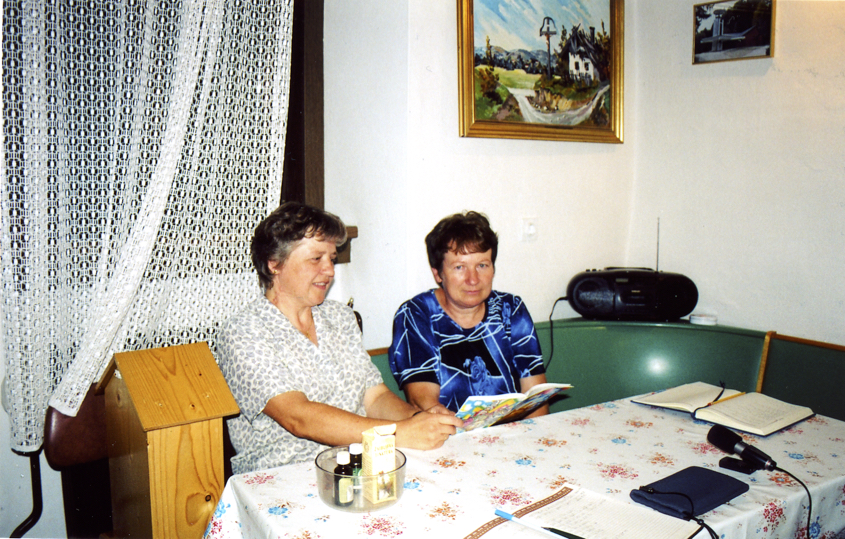
Picture 1: Traditional singers from Arnače near Velenje (Arnače near Velenje, 19th August 2003; photo: Urša Šivic; the Archive of the Institute of Ethnomusicology)
Spontaneous singing groups (whose number and composition generally shifted freely) thus turned into concert performers. The format of gatherings changes the position of traditional singers: it equalizes traditional singers with, e.g. choral singers, in the sense of their function, aesthetic, behavior and visual presentation.[11] Traditional singers still perform in line with the traditional definition, according to which they should sing spontaneously and in more intimate environments (Kumer 1996, 13), since gatherings turn their role into that of stage performers. Also in the functional sense traditional singers are close to choral groups or folk dance groups; thus, in their organizational model since the 1990s, groups of traditional singers have been transformed or established, and organized into relatively permanent ensembles. These ensembles operate within the framework of cultural, artistic, and tourism societies, or farm women's groups (see Komavec 2003, 489).
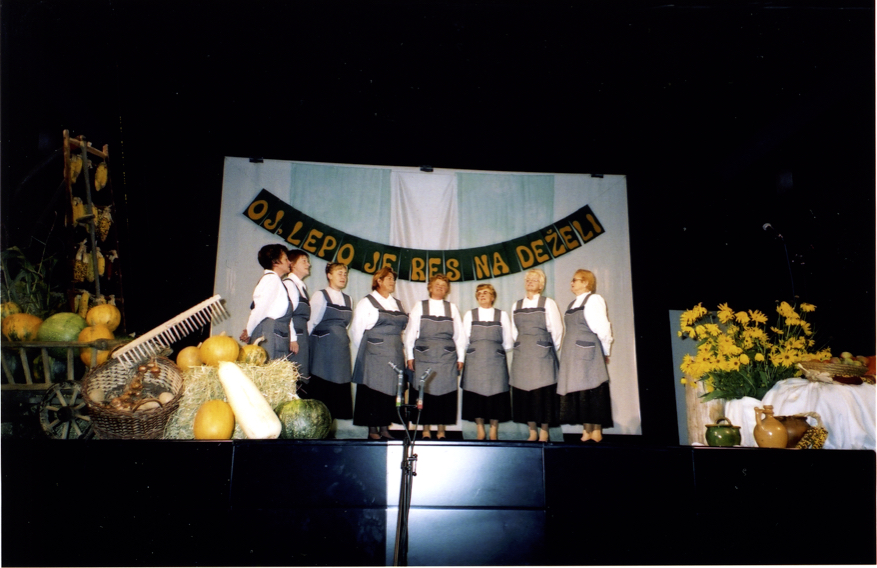
Picture 2: Traditional singers from Kapla near Vransko (Vuzenica, 7th October 2006; photo: Urša Šivic; the Archive of the Institute of Ethnomusicology)
There is another consequence to the organisational concept of traditional singing groups, i.e. group leader as appearances at gatherings and similar events call for a group to function in a coordinated manner musically and organisationally.
The rules set by a "cultural" programme of a state institution, by structural changes and traditional music venues create completely new conditions, and are consequently reflected in the changes in traditional singing. The lack of vocal technique and the pressure of stage performance has resulted in artificial tuning and the use of various aids such as pitch pipes, melodicas, and even accordions or murmuring of the initial tone before the beginning. Artificially giving the pitch is unknown in spontaneous singing and it hinders the "taking the lead" technique (Sln. petje naprej) where one singer starts singing first and the others then join in. The moment in spontaneous singing when other singers join "the lead" is not strictly defined, but they come in the harmony considering the orientation in intonation. On the other side the stage performance demands at least that much organization that the entry of the voices should be coordinated and therefore synchronous.
Group singing in most Slovenian regions is (in traditionally sense) part singing, usually three-part but also four-, five-, or even six-part; two-part singing is typical of eastern parts of Slovenia because of the influence of Hungarian traditions. Although based on evidence from an earlier, older situation in traditional singing, Zmaga Kumer already points out that four-part singing "has always been widespread across most of the Slovenian territory as it is remembered also in places where only three-part singing exists" (Kumer 2002, 79). Today the image of traditional singing is significantly different, mostly because of a lack of singing opportunities and with that a lack of singing practices. Traditional two-part singing (in parallel thirds or sixths) is not a pretentious practice and therefore there is no fear of losing it if singers have at least some singing experiences. Concerning the bass voice, the situation is completely different; this voice is evidently stagnating in singing societies and is-refereeing to performances at gatherings-one main defectiveness of today's traditional singing. In the context of losing the practice of multipart singing, selectors and mentors today often recommend singers to sing at least in three parts: the lead voice (Sln. naprej, 'lead'), the higher accompanying voice (Sln. čez, 'upper') in parallel thirds or sixths, and the bass voice beneath (Sln. bas, 'bass').
Transcription and audio example 1
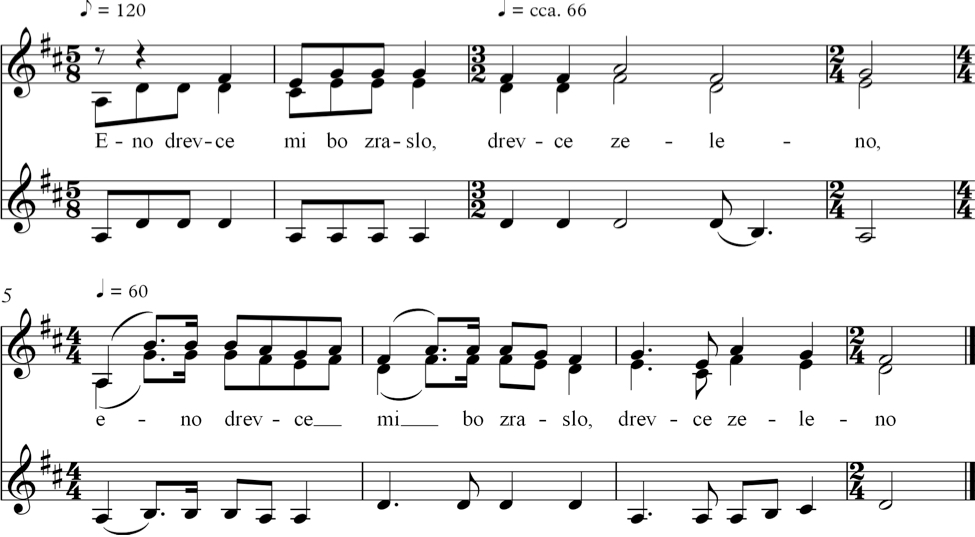
"Eno drevce mi bo zraslo" (The Archive of the Institute of Ethnomusicology, GNI M 20.661)
Place: Jastroblje in Tuhinjska Valley, Upper Carniola. Date: March 23, 1957. Sang by: Ančka Cencelj, Francka Cencelj, Francka Pistotnik and Angela Strmšek. Recorded by: Valens Vodušek.
In the formation process of present traditional singing groups, ties to the traditional ways of singing are often weak (usually, the singers have more experience with secular and church choir singing than with traditional singing). Consequently, the bass line is the first to be lost as it requires an entirely different musical mindset from the singing of the main melody or the accompaniment. Singers believe they are singing a three- or four-part harmony, but they actually sing as in the example shown below; this is in fact two-part singing with an added octave doubling of the upper voice, or the false bass (Sln. šuštar bas, 'cobbler's bass').
Transcription and audio example 2
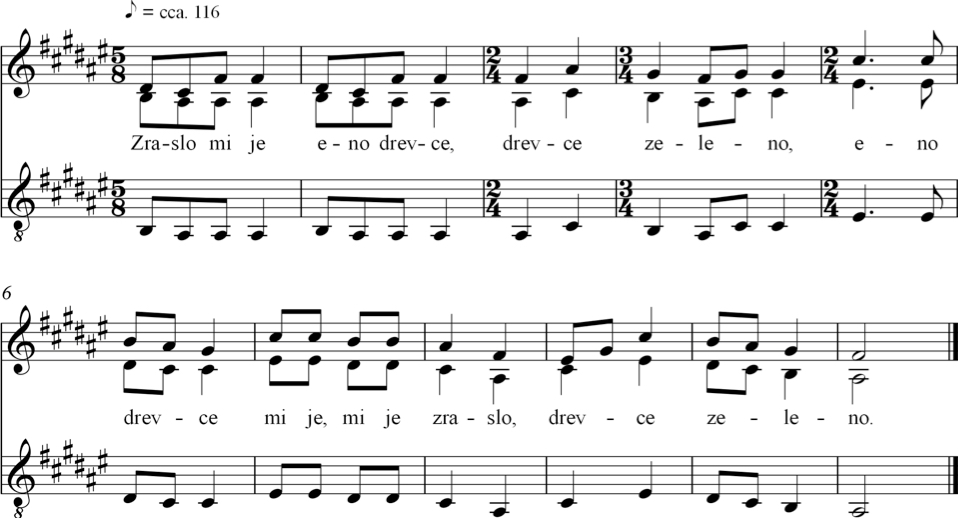
"Zraslo mi je eno drevce" (The Archive of the Institute of Ethnomusicology, GNI DAT 407)
Place: Šentilj, Styria. Date: September 2, 2006. Sang by: The Group of Traditional Singers, Cultural Society Hotiza. Recorded by: UrŠa Šivic.
False bass is not the only form of the bass voice that is becoming common in traditional singing. The movement across the main harmonics defines traditional bass. This accompanies upper voices by focusing on the main tone of the tonic and the dominant, while some other tones have the roles of passing and auxiliary notes. Singers with their choral, pop-folk music (Sln. narodno-zabavna glasba) and other musical experience enrich the traditional bass line. As a result, the harmonic rhythm (changes of harmonics) becomes faster, and the gaps in forth/fifth jump between the tonic and the dominant are filled in by the scale tones that have never been used before. From the point of view of harmonics, the voices create formations that are unfamiliar in traditional music: the turns in triads or even in seventh chords, the VII degree and others.[12]
Transcription and audio example 3
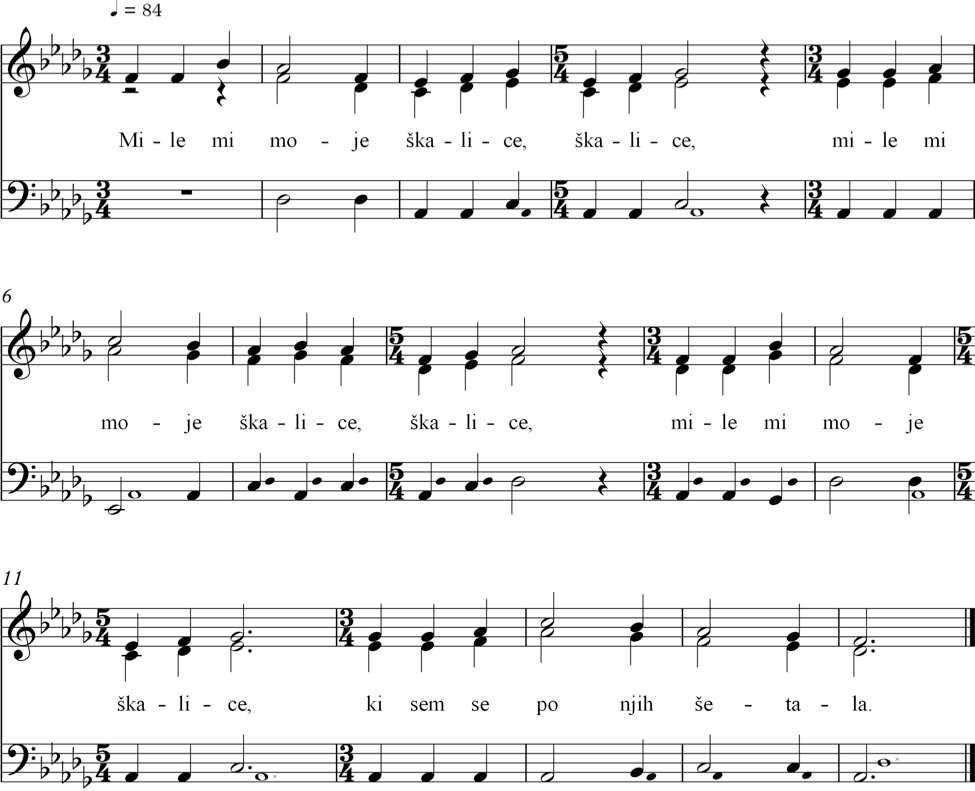
"Mile mi moje Škalice" (The Archive of the Institute of Ethnomusicology, GNI DAT 387)
Place: Sveti Peter, Istria. Date: June 30, 2006. Sang by: Vocal Group Val, Folklore Society Val Piran. Recorded by: UrŠa Šivic.
Today, singing to the accompaniment of an instrument, primarily an accordion, but also tamburitza, zither, and other instruments used for special occasions,[13] is becoming increasingly frequent. Here the influences of pop-folk music, which is based on vocal-instrumental performance, cannot be overlooked, but the tendency to add accompaniment also originates from poor vocal technique: a loud and harmonically rich instrument, such as an accordion, can mask the singers' inability to sing multiple parts and to produce open and harmonious singing-consequently the sound and harmony lose their primary roles. A further change influenced by the accordion accompaniment is the transformation of sung songs into dance songs: the accordionist, who is naturally accustomed to playing for dance, is forcing singers to sing rhythmically and metrically in a dance manner. Songs that are characteristically performed in a natural vocal manner now acquire the characteristics of a waltz or polka. Selectors warn groups that the Public Fund's instructions "explicitly reject singing with instrumental accompaniment" ([Knific] 2007, 4), but these warnings yield only negligible results; accompaniment by accordion (and the accordion itself) has become so firmly rooted in the sound image that groups rarely take these directives into consideration.
Taste is a changeable domain that is particularly rooted in the present where "there is nonetheless more musical and sound material than there has ever been" (Komavec 2003, 483). Therefore, in addition to traditional songs, the song repertoire also includes art songs, pop-folk songs, and other music genres. Singers often choose songs that are recognized as contemporary in terms of their textual and melodic structure; the media - through which they are transmitted into the song repertoire - are radio, television, audio media, performances at public festivities, etc. The motifs typical of these songs include love of one's home village, mother, local church, flowers, and so on. In terms of melodic and harmonic contours, they are close to pop-folk songs: for example, the harmony diversity, chordal melody, and modulations. The songs are a reflection of "expressing the traditional language" (Kumer 1996, 10) of today, which also means a reflection of experiencing and helping influence the content of the surrounding world. The criterion according to which selectors should "encourage the performance of older songs and melodies, but also approve of the performance of newer songs or melodies to which traditional character can be ascribed" ([Knific] 2007, 4) is more or less vague. However, it is precisely due to the evaluators' orientation that narrative, dialect, and caroling songs as well as songs with a large number of stanzas and a local theme are returning to these gatherings; in short, this is a selection that should revive and preserve the songs that most singers do not know (anymore) or find uninteresting because of today's aesthetic criteria.
Agogic and dynamic changes that define the interpretation are not known for traditional singing (Kumer 2002, 81), but instead are connected to performing and interpretational methods of pop-folk music, pop songs, choral music, etc.
Transcription and audio example 4

"Mlada deva šla je 'z domovine" (The Archive of the Institute of Ethnomusicology, GNI M 49.250). Place: Šmartno na Pohorju, Styria. Date: June 4, 2000. Sang by: Traditional Singers, Cultural Society 'Ivan Cankar', Jurovski dol. Recorded by: Urša Šivic.
With their instructions, evaluators warn that traditional singing is interpretationally "static" and that using gestures with individual words is inappropriate. This is a recent domain that is primarily a behavioral mannerism of pop-folk bands and folk dance groups.[14]
Choral singing (both secular and church) is the most widespread amateur music activity in Slovenia; therefore, traditional singers are people that alternate between the role of choral singer to the role of traditional singer and vice versa. In this way performance practices and aesthetic criteria are also continually transferred, despite the fact that this involves - more in theory than in practice - two different genres. In this kind of traditional singing, the choral sound of the women's voices (especially sopranos) is also noticeable; it is a light color influenced by high intonation, whereas in the traditional singing style this intonation is more natural and lower, and the color is warmer.
Transcription and audio example 5
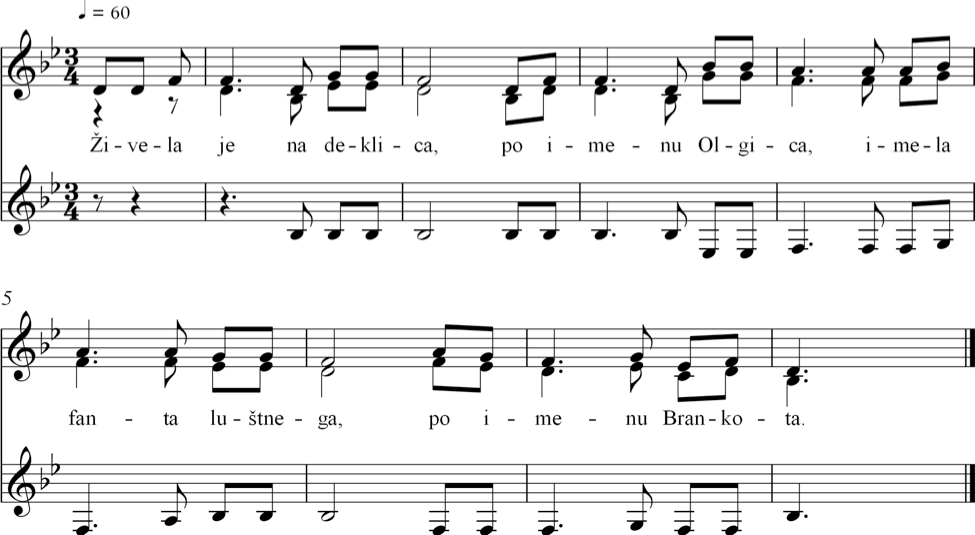
"Živela je na deklica" (The Archive of the Institute of Ethnomusicology, GNI M 46.794).
Place: Čezsoča, Littoral. Date: 1996. Sang by: Pavlina Kavs, Tilka Kenda in Ana Mlekuž.
Recorded by: Ambrož Čopi and Boris Rener.
The leading melody of the song "Živela je na deklica” sang by older female singers starts with D (Example 5), while the leading melody of young singers starts with g1, so quite fourth higher (Example 6). This is an essential and evident difference in the singing register and the temper: the first example is darker and the second is tense and bright, close to a choral singing manner.
Transcription and audio example 6

"Živela ena deklica" (The Archive of the Institute of Ethnomusicology, GNI DAT 387).
Place: Sveti Peter, Istria. Date: June 30, 2006. Sang by: Buške čeče, Folklore Group, Cultural Society Bovec. Recorded by: Urša Šivic.
In places where choral singing is a dominant music form (e.g., in the Littoral), traditional singing possesses a noticeable and very distinct feature of quick singing without the pauses that in normal traditional singing are measured freely and outside the metric sequence. The tempo is that parameter of traditional singing, which is going through significant changes in the way of speeding up, especially when we see it in light of the comparison of the older with the newer examples of traditional singing. To illustrate, let us go back to the case we have already seen in the intonation changes. The meter of the more traditional version of the song Živela je ena deklica is ♩ = 60, while the newer version is ♩ = 96; the first is more of a largo and the second is in a completely different environment, that of an andante.
Types of groups that today perform as formed groups of traditional singers vary: from two female singers to mixed groups with around fifteen members. Spontaneous traditional singing known to the Institute's associates before the time of such mass formations of singing groups includes a more or less random number of informants. Today, the most common singing groups have from four to ten members, less often three or two. Formations with over ten members are a rarity. If spontaneous traditional singing is more casual, i.e. the singers can sing more or less neatly, it is an appearance at an event that calls for better organisation. Here bigger groups are in a worse position, and sound-wise they are weaker as they combine many voices that are not very good. These groups often lack discipline or singing predispositions in order to develop the orderly singing of choirs, which an appearance at a gathering can require. The fact that these groups actually morph (rename themselves) into traditional singers from singing choirs that are given low marks at choral singing contests speaks for itself.
With all the changes in classifications and in traditional singing itself, it is essential that we take into account the regional aspect. The gatherings can paint a fairly clear map of traditional singing cultures in Slovenia. Where traditional singing activities have diminished, they have in fact transformed into another musical activity or this new musical activity has taken over traditional singing. Today, we can differentiate among several influences: the revival of traditional music and choral singing in Littoral and Istria, pop-folk music and the culture of vocal octet groups in the Celje region and Carinthia, pop-folk music in Upper Carniola and others. An island of traditional singing that best meets the assessment criteria of gatherings is the area of Lower Carniola and South Styria. Of course, here we face a dilemma of the question of whether it is morally right to assess traditional singing in an environment with a specific musical-cultural form with the criteria taken from another, different environment.
What is "correct" traditional singing?
Finally, how does the intervention of an institution affect traditional singing changes-or, to be more precise, the changes of these changes? The programme of an institution is partly still oriented towards presenting traditional music. However, the other segment is retrograde, as it uses the agreed criteria to get to the most "original" image of traditional music. The process of changing a certain traditional music culture is turned into an idealized form of traditional music, but only to a certain extent. In most other, non-revised situations, the process of changes in singing traditions is natural. Within a certain segment, singers that receive comments and instructions from selectors also still perform music in spontaneous situations (primarily at festivities, on excursions, at weddings, etc.), but institutional influences do not reach them there. There are also groups that do not take part in "official" gatherings, i.e. gatherings of the Public Fund, which means they are never "subjected" to the comments of a selector on what is considered traditional and what is not from the viewpoint of the central institution. In addition, the institutional orientation policy has only a small range of effects because there are numerous similar but privately organized events in the field, which are usually extremely mixed from the conceptual viewpoint (traditional singers and musicians, pop-folk bands, sketch comedies, etc.) and offer a wide selection of musics to the people.
Observing traditional music through the eyes of the selectors' remarks about "errors" precisely indicates the characteristics of today's traditional music conceptual and aesthetic image-those elements that one is not aware of during the normal process of changing tradition, but which become clearly evident and systematic through the evaluation criteria. Slovenian traditional singing has changed significantly (in some segments and regions) from the state that the institutions embalm, preserve, or try to restore. Slovenian traditional singing is no longer only part singing, as the following statement asserts: "Unison singing in fact does not exist in Slovenia." (Kumer 2002, 76) The frequently-quoted phrase "Three Slovenians make a choir" has long ago ceased to reflect true Slovenian traditional singing culture. The breakup of male groups and other singing groupings where singing used to be a constant (singing still needs to be trained and the skill needs to be regularly practiced) caused the widely known multipart Slovenian singing to diminish to the point where just the melody is sung in unison. A male group that meets once a year on the occasion of a tradition and whose members constantly change[16] cannot be able to know how to sing anything but in unison.
On no account can the numerous groups that engage in part singing (organized or spontaneous) be overlooked, but it has to be emphasized here that Slovenian singing also involves unison singing. Thus this must be added to the list of Slovenian singing techniques, even though this is not in line with historical data and general belief. This article also does not wish to overlook the metric diversity and other special features of the Slovenian traditional musical and metric structure, but instead hopes to stress that these features are disappearing in the universality of two metric patterns; that is, the regular two- and three-beat measures as the results of strong influences of rhythmic techniques used in pop songs, and pop-folk polkas and waltzes.
These gatherings' criteria arouse mixed feelings in traditional singers (and instrumentalists) because they promote conceptual and aesthetic criteria that are not familiar to them. The institutional criteria reject most of the material people transfer to their own traditions in the form of various types of visual and sound information as "a mix of numerous compositions, styles and social contexts, which rarely appear in such isolation as to preserve clear stylistic boundaries" (Bohlman 1988, 122). This includes the singing of pop-folk singers, choral singing, the musical, lyrical and aesthetical content of pop-folk music, popular songs, secular music and choral liturgy, and others. By giving instructions at the gatherings, the selectors create an idealized image for further meetings and strive to form the purest possible method of presenting traditional music culture as "original" as possible. The national gathering of traditional singers and musicians is the final event after the preliminary elimination rounds, and thus represents a purified, idealized, and typical example of the presented culture. In this context, groups are chosen - women's and men's, respectively[17] - and they perform a cappella, i.e. without instrumental accompaniment, because use of an instrument is one of the main "prohibitions" of the institution. The repertoire selection suits institutional directions that recommend performing older songs; singing is arranged as traditional part singing and others.
Although it seems that traditional singing is in steady decline (which is a historical constant in understanding the traditional music of any time), the increasing number of performers at gatherings proves that they succeed in achieving one of their goals, which is to encourage people to become involved in this activity. At the gathering of the Littoral region, for example, only four groups participated in 2002 (S. n. 2002), but in 2006 the number increased to thirteen groups (S. n. 2006). The gatherings do, after all, represent a cultural event in the local environment, but as a rule the audience does not include young people or listeners that are not directly connected with the event (relatives, neighbors, etc.). Sometimes it even occurs that the participants are also the only audience, and thus the transmission flow of the material presented is very quickly closed.
Final questions
Observation of differences in traditional singing opens up a variety of questions. At this point, the most interesting questions are those that come up during the observation of disparities between the wish to preserve traditions and the actual direction of the changing traditions. The comparison, which is clearly illustrated in our music transcriptions, is a premonition of the future of Slovenian traditional song and traditional singing.
Respect for original (also "performed" traditional) music is generally accepted and logical; it is manifested in the institutional form and public support as a banner of nation-building and identity-creating preservation of heritage. According to the analogy of musical tradition, we can say that a certain musical form exists as long as "people need it" (Muršič 1994, 24), therefore its functional or aesthetical needs define its future fate. It is not easy to find an argument to support the idea that conservation and museum-like presentation of traditional music is one of the forms of the functional or aesthetic needs because the gatherings as formulated, unspontaneous and directed cultural events are a far cry from the historically functional traditional music. Unless, of course, we accept (and such revitalisation of the notion practically has no sense) that traditional music has (also) become a music show in the function of a (cultural) event. If tradition is "a living thing and as an open system a recursively self-fulfilled and changing whole" (Muršič 1994, 25), then the changes in traditional music represent a new form of tradition of traditional music; or we are faced with a different question: is the interference with the image of tradition something living and an open system of this image?
"The fact that our stage formations are artificial cannot be avoided. However, understanding tradition can prevent deviations from becoming bigger than needed due to the desire to show the traditions to the audience" (Možina 2006, 27). This citation reflects a reality of the gatherings: the fact that they are artificial stage presentations of traditional heritage and that this is a directed and revised form of culture. The question is if such presentation of traditional music is really the wish of the audience or it is the necessity of a broader, generally learned need to preserve, which in turn creates institutionalisation of traditional music. Within this frame, traditional music has transformed from the spontaneous to the systematic and arranged.
Notes
[1]
The article focuses on the singing part of the gatherings.
[2]
The first gatherings were organized by Mirko Ramovš, an ethnochoreologist from the Institute of Ethnomusicology and member of the expert committee of the Association of Cultural Organizations (Sln. Zveza kulturnih organizacij Slovenije), today known as the Public Fund for Cultural Activities of the Republic of Slovenia (Sln. Javni sklad Republike Slovenije za kulturne dejavnosti).
[3]
Recently, the discourse about reforming activities has been prevalent, since the original idea - presenting traditional music in historical form - is supposed to be out-of-date and specifically not consistent with principles of the Fund, which is the event organiser. The revitalisation principle has therefore joined the presentational principle. The new guidelines are to encourage the younger generations to get involved in traditional singing because as it is today, mostly older generations take part in traditional singing activities. Due to conceptual and ideological changes of the gatherings, many of statements presented here might become outdated or inaccurate in time.
[4]
Of course, this project did not just spring up overnight; similar presentations had already been included at the Yugoslav folklore festival in Koper in the 1960s. (Ramovš 2006)
[5]
The Public Fund for Cultural Activities of the Republic of Slovenia is an institution that, through branch offices
throughout Slovenia, creates a cultural network and handles amateur activities in film and video, folklore and ethno,
theater and puppet shows, music, fine arts, inter-media, literature, and dance (cf. www.jskd.si).
[6]
Six regional gatherings take place in Slovenia: in Upper Carniola, in the Littoral and part of Inner Carniola, in
Prekmurje and part of Styria, in Western Styria and Carinthia, and in Lower Carniola, White Carniola, and part of
Inner Carniola. Every regional gathering is divided into a different number of local gatherings: gatherings in
Prekmurje and part of Styria have seven local gatherings, although the Carniolan and Littoral gatherings do not have
preliminary local meetings because of the small number of groups. (To apply to 2006.)
[7]
Within the Public Fund, the selection is also carried out every year in other areas (in folklore and amateur cultural
activities). In addition to the gatherings of traditional singers and musicians, these include the gatherings of adult
and children's folk dance groups, revues of choirs and smaller vocal groups, revues and competitions of tamburitza
group and brass bands, etc. (cf. www.jskd.si).
[8]
It is difficult to define which historical period of traditional music this occurred in because the processes of change
are slow and differ from one region to another. It is certainly traditional singing, the image of which can be
imagined on the basis of the field recordings; therefore we are talking about the mid-century period of the 20th century.
Traditional singing of this period cannot be seen as a homogenous whole and so the examples described and
presented in this article do not apply to every geographic and cultural environment. The characteristics of a change
are in some places exhibited as the prevailing cultural content, while somewhere else the same is a rarity.
[9]
Expert commentaries are complemented by educational seminars (also organized by the Public Fund) on traditional singing, music, and dance.
[10]
In Adlešiči, White Carniola, for instance, there are two groups of women's traditional singers (older and younger)
that operate both publicly and privately as two separate organizations. The group of younger singers is thus creating
its own manner of singing of borrowed local songs and changing the form of local Midsummer Night caroling.
[11]
This article does not discuss the clothing culture that also results from putting traditional singing on the stage:
uniform clothes in the sense of choir uniforms, folk costumes, such as those used by folk dance groups, and the
aesthetic image of the clothing culture of pop-folk bands and other musical genres.
[12]
Small notes represent the expected line of traditional bass voice.
[13]
In traditional sense, Slovenian singing is principally, whether vocal or instrumental, for dance accompaniment. Data about singing with accordion accompaniment are rare: most such events have occurred at various festivities and usually occasional songs were sung in this manner.
[14]
A few examples of verses that are accompanied with gestures: "men se po glavc vrti" (my head is spinning) - one hand makes a circle next to the head; "kikle tri, nobene cele" (three skirts and all are torn) - three fingers are shown; "kaj mi nuca lepota" (what's the use of beauty) - the singers stroke their faces; "smo zapeli iz srca" (we sang straight from our hearts) - they point to their hearts.
[15]
In Slovenia, there are around 2,300 vocal groups.
[16]
This is the case of a male group that observes Florian carol-singing tradition. Instruments accompany them (e.g. an accordion, a guitar and a baritone horn), however they only sing in unison. (GNI DAT 380)
[17]
Mixed choruses are usually vocally weaker; they rarely originate from the singing tradition and, because they are
new, lack singing practice.
References
Arhiv Glasbenonarodopisnega inštituta ZRC SAZU The Archive of the Institute of Ethnomusicology ZRC SAZU.
Bohlman, Philip Vilas. 1988. The Study of Folk Music in the Modern World. Bloomington & Indianapolis: Indiana University Press.
The Public Fund. 2006. Javni sklad Republike Slovenije za kulturne dejavnosti [The Public Fund for Cultural Activities of the Republic of Slovenia]. https://www.jskd.si.
Klobčar, Marija. 2000. "Od pašnika do odra [From the Pasture to the Stage]." Traditiones 29 (1): 93-106.
[Knific, Bojan]. 2007. Posvet s strokovnimi spremljevalci srečanj pevcev in godcev [Consultation with Selectors of Gatherings of Folk Singers and Folk Musicians.] Ljubljana. (Typescript)
Komavec, Maša. 2003. "Ljudska glasba v Sloveniji danes [Folk Music in Slovenia Today]." In Čovek i muzika/Man and Music, ed. by Dimitrije Golemović, 485-503. Belgrade: Vedes.
Kumer, Zmaga. 1996. Vloga, zgradba, slog slovenske ljudske pesmi [The Role, Structure, and Style of Slovenian Folk Song]. Ljubljana: ZRC SAZU.
______. 2002. Slovenska ljudska pesem [Slovenian Folk Song]. Ljubljana: Slovenska matica.
S. n. 2003. Medobmočno srečanje etno-vokalnih skupin. Osp, 5. julij 2003 [Interregional Gathering of Ethnic Vocal Groups. Osp, July 5, 2003]. Koper: Medobmočna koordinacija Koper; Osp: Kulturno društvo Domovina Osp.
______. 2006. Medobmočno srečanje pevcev ljudskih pesmi in godcev ljudskih viž. Sveti Peter, 30. junij 2006 [Interregional Gathering of Folk Singers and Folk Musicians. Sveti Peter, June 30, 2006]. Piran: Območna izpostava JSKD Piran.
Možina, Malči. 2006. "Srečanja in strokovni spremljevalci - ali ene in druge sploh potrebujemo? [Gatherings and Selectors - Do We Need Them at all?]." Folklornik 1: 26-27.
Muršič, Rajko. 1994. "Etno, ljudska, folk in popularna ...2 [Ethnic, Folk, and Popular ...2]." Razgledi 15: 24-25.
Ramovš, Mirko. 2006. Conversation with Mirko Ramovš, Ljubljana, December 29. (Minidisc)
Appendix
Audio example 1 >
https://phaidra.univie.ac.at/o:559952
Eno drevce mi bo zraslo (GNI M 20.661)
Place: Jastroblje in Tuhinjska Valley, Upper Carniola
Date: March 23, 1957
Sang by: Ančka Cencelj, Francka Cencelj, Francka Pistotnik and Angela Strmšek
Recorded by: Valens Vodušek
Audio example 2 >
https://phaidra.univie.ac.at/o:559951
Zraslo mi je eno drevce (GNI DAT 407)
Place: Šentilj, Styria
Date: September 2, 2006
Sang by: The Group of Traditional Singers, Cultural Society Hotiza
Recorded by: Urša Šivic
Audio example 3 >
https://phaidra.univie.ac.at/o:559950
Mile mi moje škalice (GNI DAT 387)
Place: Sveti Peter, Istria
Date: June 30, 2006
Sang by: Vocal Group Val, Folklore Society Val Piran
Recorded by: Urša Šivic
Audio example 4 >
https://phaidra.univie.ac.at/o:559949
Mlada deva šla je z domovine (GNI M 49.250)
Place: Šmartno na Pohorju, Styria
Date: June 4, 2000
Sang by: Traditional Singers, Cultural Society 'Ivan Cankar', Jurovski dol
Recorded by: Urša Šivic
Audio example 5 >
https://phaidra.univie.ac.at/o:538055
Živela je na deklica (GNI M 46.794)
Place: Čezsoča, Littoral
Date: 1996
Sang by: Pavlina Kavs, Tilka Kenda in Ana Mlekuž
Recorded by: Ambrož Čopi and Boris Rener
Audio example 6 >
https://phaidra.univie.ac.at/o:538053
Živela je na deklica (GNI DAT 387)
Place: Sveti Peter, Istria
Date: June 30, 2006
Sang by: Buške čeče, Folklore Group, Cultural Society Bovec
Recorded by: Urša Šivic
Citing this article:
Šivic, Urša. 2016 [2007]. "The Influence of Institutionalized Standards on the Transformation of Traditional Singing." Translated from Slowenian by Tanja Kuret and Jessica Sloan-Leitner. Translingual Discourse in Ethnomusicology 2: 63-81. doi:10.17440/tde011







